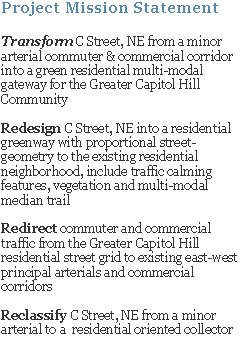It appears there was a great discussion amongst Hill residents at Capitol Hill Restoration Society's (CHRS) September Transportation Forum regarding commuter traffic’s proximity to neighborhoods and its detrimental impact to residents' health and quality-of-life.
Hopefully, this forum is the starting point for the greater Capitol Hill community to get serious about transportation issues effecting Ward 6. We need to discuss and establish, with DDOT and CM Tommy Wells, definitive Ward and City level transportation goals and plans, along with an implementation time-lines, to address regional traffic patterns effecting our neighborhoods.
There can be a balance between commuter motorists’ objective to efficiently and safely move in and out of the city and residents’ desire to live, play, work and raise a family in a healthy, safe urban community environment.
Please refer to the below CHRS article, extracted in its entirety from CHRS's October 2009 newsletter (pages 10 & 11). Some text has been bold to highlight particular topics. And, thanks to Beth Purcell, CHRS President, for sending the tip.
Transportation Forum Heard By Many
by Dick Wolf
A nearly full house of Capitol Hill residents heard about a broad range of topics at the CHRS Transportation Forum on September 21. Even without the presence of a DDOT representative (due to a tangle of conflicting obligations), Peter May, the Land Use Coordinator for the National Capitol Region of the National Park Service (NPS);Tom Grahame, former CHRS Transportation Committee chair; and Dick Wolf, CHRS City Planning chair and organizer of the forum, addressed a host of transportation issues that affect the Hill.
Peter May, a Hill resident and former DC government official, focused on the interests of the NPS with respect to a variety of city initiatives. Recently, the National Capitol Planning Commission (NCPC) considered the 11th Street Bridge project, which involves a variety of federal issues. Mr. May, who represents the Secretary of the Interior on the Commission, questioned the inclusion of a light rail/trolley line on the proposed set of bridges with cars powered by overhead wires. While NPS likes transit, he pointed out that overhead wires of any kind are prohibited by a 100+-year-old federal law covering the “Old City of Washington” which is largely the L’Enfant plan for the city and includes all of Capitol Hill. Previous trolley lines in DC were powered by underground systems.
Also subject to federal review would be any alterations to the streets in the Old City, such as street furniture, loading platforms, and the like because the L’Enfant plan, including its streets, is listed on the National Register of Historic Places. At NCPC’s September meeting, the Office of Planning Director, Harriet Tregoning, noted the city’s commitment to conduct an Environmental Impact Statement to determine the various effects of a streetcar/trolley system in DC.
Mr. May also addressed the issue of federal involvement in the planning for any changes in Pennsylvania Avenue between the Capitol and Barney Circle. Though he said making Pennsylvania Avenue a monumental approach to the Capitol is not on the NPS agenda now, it is possible that in the future it could be.
Tom Grahame focused on addressing the environmental health issues of heavy traffic in the city. His review of numerous recent studies showed that within 150 feet of heavily trafficked streets and highways, there was a substantial increase in health problems (asthma, chronic obstructive pulmonary disease, bronchitis, and tiny particulates and biologically active chemicals that are dangerous to humans. In response to these studies, California has banned construction of highways within 150 feet of schools and housing developments. The 11th Street Bridge project would bring additional new highway lanes and auxiliary structures carrying 50,000 more vehicles per day within 150 feet of Tyler Elementary as well as numerous residential housing areas and developments. The 11th Street Bridge project EIS fails to address these issues.
He also addressed the need for better policies regarding commuter parking and the effectiveness of speed cameras in slowing down commuter traffic, especially in the Rosedale neighborhood.
Dick Wolf pointed out a number of planning issues pertaining to Hill transportation problems and projects. Karina Ricks, the Associate Director of DDOT for Planning, is planning on letting a number of contracts to study more discretely the vehicular traffic issues in DC. Until now, the models used to undergird planning for transportation in the city have been based on regional models used by the Transportation Planning Board of the Metropolitan Washington Council of Governments. It is felt that these models are dated and fail to adequately account for traffic impacts in the city.
In regard to the trolley/light rail proposals, Mr. Wolf pointed out that it was the tail wagging the dog. The District has purchased three rail cars and is laying tracks without any planning for the kind of system to be used; a system map; sufficient knowledge about the kind of infrastructure that would be needed for a system; and cost analysis(DDOT says $34 million a mile; the recently completed 20 mile light rail system in Phoenix cost $70 million a mile). Most importantly, there have been no community meetings on the Hill or anywhere else except H Street, NE, to discuss these issues. Few people in our audience knew anything about a trolley/light rail system on the Hill, which DDOT’s Short-Term Implementation Plan map shows running along H Street, NE; 8th Street; and M Street, SE. Massachusetts Avenue, NE, is also under consideration.
Finally, our large group of attendees asked a number of questions and raised concerns which contributed to the overall understanding of these important issues. We didn’t solve any problems, but we did enlighten and raise awareness.
Tuesday, November 10, 2009
Subscribe to:
Post Comments (Atom)


No comments:
Post a Comment